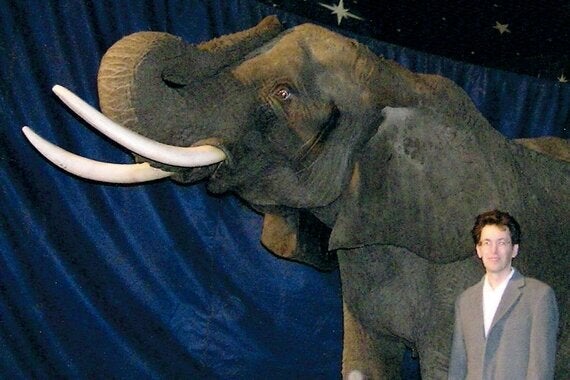Robocop was billed as the future of law enforcement. But is Big Yorgi, a $50,000 robot elephant, the future of circus entertainment? Robo-jumbo is the star of Mexico's Magic Spacial Cyber Circus. The life-size plastic pachyderm walks, curls his trunk and kicks footballs. But as Mexico stands on the brink of a ban on real circus animals, due to come into force this July, their robotic replacement has reportedly been playing to sparse audiences - and I fully understand why.
Like many people, I was brought up to believe that forcing animals to perform in a circus was at worst cruel and at best distasteful. It was the daredevilry of human performers that attracted me to the modern world of the circus. But when I began researching my book Circus Mania about life in the big top, I realised I would have to visit at least one of the few remaining circuses with animals to get a glimpse into the history of an art form that was founded in London, in 1768, by the horseman Philip Astley.
Sitting ringside beneath canvas, I discovered a magical world that completely changed my views. There is something transporting about a procession of plumed spotted horses cantering through sawdust. It's thrilling to sit so close to elephants that you find yourself leaning back in your seat as they swish their trunks around, sniffing the air.

The author meets one of the last elephants to appear in a British circus (Photo: author's collection)
I found the gentle routine of the tiger trainer particularly mesmerising. The tricks were akin to a domestic cat jumping onto a chair in return for a stroke, or in this case a titbit of meat.
Of course, I looked for signs of cruelty, but the beautiful condition of the animals, their composure in the ring and calmness around visitors backstage belied suggestions of mistreatment. My interviews with several trainers left no doubt that they love their animals, and the scientific evidence attests to the care they receive.
The Radford report, commissioned by the last government, found no welfare grounds to ban animals from the circus. An earlier 18-month study by Dr Marthe Kiley-Worthington, which was sponsored by the RSPCA and published as Animals in Circuses and Zoos: Chiron's World?, concluded that training was no harsher than in kennels and riding schools. Kiley-Worthington also found that circus animals show no distress during transportation - they quickly become accustomed to regular short journeys and board their transport without fuss.
It's true circuses can't replicate an animal's natural environment, but does that mean the one they provide is worse? Animals in the wild face a daily fight for survival. They are either killed by predators or die of hunger. Circus animals are well fed, sheltered, have no predators and receive veterinary care. As a result they live two or three times as long as their wild cousins. Is it such a stretch to believe they enjoy their interaction with humans as much as any pet?
The reason so many harbour the instinctive belief that circuses are cruel is because media coverage over the past 30 years has been dominated by the message of animal rights protestors and many of us never bother to go along to see for ourselves.
That's our loss, and it would be a massive loss to our culture if Britain was to follow Mexico in banning animals from a form of entertainment that we gave to the world.
All-human circuses have become fashionable. Cirque du Soleil is the biggest theatrical producer in the world. We take pride in a National Centre for Circus Arts, which trains world class acrobats in the heart of London.
But although much contemporary, theatre-based circus is innovative and exciting, it appeals mainly to a grown-up metropolitan aesthetic. It seldom caters for the family audience that once thrilled to the antics of polar bears and sea-lions when the annual circus broadcast from the big top of Chipperfields or Billy Smart was as much a part of Christmas Day television viewing as the Queen's Speech.
That audience, which would probably never attend a modern 'cirque'-style show, is still out there, and the handful of traditional circuses that travel the country continue to provide for it, with animals their main attraction.

Britain's last lion trainer, Thomas Chipperfield (Photo: Douglas McPherson)
In an increasingly sanitised and digitalised age, the interaction of trainer and animal in the sawdust circle provides something real and raw that no other form of entertainment can offer. Rather than demeaning animals, it impresses all ages with their skill and intelligence, and enhances our relationship with nature.
The circus with animals is a place where children make memories for life and the old become children again. Instead of banning it, we should be rediscovering and preserving it for future generations.
Because, as Mexican audiences are discovering, robot elephants just wouldn't be the same.
This post originally appeared on the author's blog www.circusmania.blogspot.co.uk